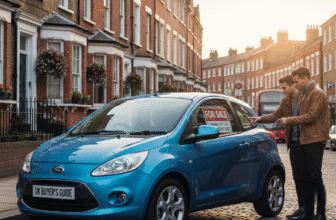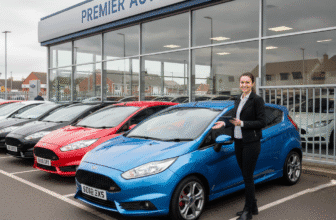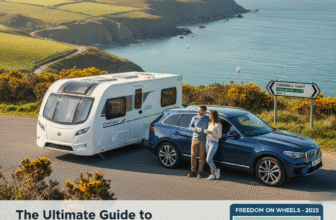
Your Ultimate Guide to Finding the Best Second-Hand Cars for Sale Near You
The thrill of getting a new car is undeniable. The gleam of the paintwork, that ‘new car smell’ (even if it’s just a really good air freshener), and the promise of new adventures. But let’s be honest, the hefty price tag of a brand-new vehicle can quickly bring you back down to earth. That’s where the wonderful world of second-hand cars comes in. Buying a used car is a savvy move, allowing you to get a higher-spec model for your money and avoid the steepest part of the depreciation curve. However, navigating the used car market can feel like a daunting task, fraught with potential pitfalls. Phrases like “sold as seen,” “clocked mileage,” and “outstanding finance” are enough to give anyone pause.
Fear not! This comprehensive guide is here to demystify the process. We’ll walk you through everything you need to know to confidently find, inspect, and purchase the perfect second-hand car right on your doorstep. Forget endless, confusing searches; it’s time to find a reliable motor that fits your life and your budget.
Where Should You Begin Your Search for a Used Car?
The days of trawling through printed classifieds are long gone. Today, your search for a “second-hand car for sale near me” begins online, but it shouldn’t end there. A blended approach, combining digital research with physical viewings, is the key to success. Let’s break down the main places you’ll be looking.

1. The Big Online Marketplaces
These are the giants of the UK used car scene and the first port of call for most buyers. They offer vast choice and powerful search filters to help you narrow down your options by make, model, price, mileage, and importantly, distance from your postcode.
- Auto Trader: The undisputed king of UK car classifieds. It has the largest inventory of cars from both private sellers and dealerships of all sizes. Its reputation is strong, and the platform includes helpful features like free basic history checks and price indicators.
- Motors.co.uk: A major competitor to Auto Trader, also boasting a huge selection. They often have clever tools and guides to help you through the buying process, making it very user-friendly.
- Gumtree Motors: While it’s known for everything from furniture to jobs, Gumtree’s motor section is extensive. It’s particularly strong for private sales, which can mean lower prices, but it requires a bit more diligence from the buyer.
- eBay Motors UK: eBay offers a mix of auction-style listings and “Buy It Now” classifieds. You can sometimes find a real bargain here, but the auction format adds another layer of pressure. It’s crucial to do all your checks before placing a bid.
2. Franchised Main Dealerships (Approved Used)
If peace of mind is your absolute top priority, then an “Approved Used” car from a main dealer (like a Ford dealer selling a used Ford) is your best bet. These cars come with a premium price tag, but you’re paying for a suite of assurances that significantly reduce the risk.
- Rigorous Multi-Point Checks: The car will have undergone a thorough inspection by manufacturer-trained technicians.
- Comprehensive Warranty: You’ll typically get at least a 12-month warranty, often including breakdown cover.
- Verified History and Mileage: The dealer guarantees the car’s history is clean and the mileage is genuine.
- Often Newer Stock: They usually deal in cars that are only a few years old with lower mileage.
3. Independent Car Supermarkets
Think of giants like Arnold Clark, Evans Halshaw, or Motorpoint. These businesses operate on a massive scale, stocking hundreds, if not thousands, of cars across huge sites. Their model is based on high volume and often fixed, no-haggle pricing.
The advantage is the sheer amount of choice in one place, allowing you to compare different makes and models side-by-side. The prices are very competitive, and they usually offer their own warranties and finance packages. The experience can be a bit less personal than a smaller dealership, but for choice and price, they are hard to beat.
4. Local Independent Garages
Don’t overlook the smaller, local dealerships in your area. A reputable independent garage often relies on its local reputation to survive, meaning they are more likely to sell quality cars they have sourced and inspected themselves. You can build a relationship here, and they might have sourced the car from a local owner you might even know! Prices are often fair, and the service can be much more personal.
5. Private Sellers
Buying privately offers the best chance of bagging a bargain, as you’re cutting out the dealer’s overheads and profit margin. You’re buying directly from the owner, who can give you a detailed first-hand account of the car’s life. However, this is the riskiest route. There is no warranty, and consumer rights are significantly reduced—the car only needs to be “as described.” This is where your own checks and inspections become absolutely critical.
The Essential Pre-Purchase Checklist: Your Shield Against a “Dud”
Found a car that looks promising? Excellent. Now, before you even think about arranging a viewing, it’s time for some crucial homework. This stage is non-negotiable and will save you time, money, and heartache.
Step 1: Budget Beyond the Screen Price
The price of the car is just the beginning. You need to factor in the total cost of ownership:
- Insurance: Get some insurance quotes for the specific models you’re considering. A sporty, high-performance model might have a surprisingly low purchase price but an eye-watering insurance premium.
- Vehicle Excise Duty (VED) or “Road Tax”: For cars registered after 1st April 2017, the rate is mostly flat, but for older cars, it’s based on CO2 emissions. For some high-emission older cars, this can be over £600 a year! You can check the exact rate on the GOV.UK website.
- Running Costs: Consider fuel economy (MPG), servicing costs, and common faults for that particular model. A quick search on owner’s forums can be incredibly revealing.
- Immediate Maintenance: Does the car need new tyres? Is a major service due soon? Factor these immediate costs into your negotiation.
Step 2: The Vehicle History Check – Your Most Important Investment
This is the single most important £10-£20 you will spend during your car-buying journey. A full vehicle history check (from services like HPI, The AA, or RAC) on the car’s registration number will tell you things the seller might not. It reveals:
- If the car has outstanding finance: If it does, the finance company legally owns the car, not the seller. It could be repossessed even after you’ve bought it.
- If it’s been recorded as stolen: A vital check to ensure you’re not buying stolen goods.
- If it’s been declared an insurance write-off: It will detail if the car has been in a serious accident and categorised (e.g., Cat S, Cat N). While some repaired write-offs can be fine, you need to know what you’re buying and ensure the repair work is of a high standard.
- Mileage discrepancies: It checks for inconsistencies in recorded mileage from previous MOTs and services, a key sign of “clocking.”
Never, ever buy a used car without performing one of these checks.
Step 3: Scrutinise the Paperwork
When you go for a viewing, ask to see all the documents. They tell a story that’s just as important as the car’s physical condition.
- The V5C Logbook: This is the official registration document. Check that the Vehicle Identification Number (VIN) on the document matches the VIN on the car (usually on the dashboard and a sticker on the driver’s door shut). Crucially, ensure the name and address of the seller match the details on the V5C. If they don’t, ask why. If you’re at a private residence, does the address on the V5C match where you are viewing the car? If not, walk away.
- The MOT History: Don’t just look at the current certificate. Go to the GOV.UK “Check MOT History” service online. All you need is the registration number. This free service shows you the entire MOT history of a vehicle, including pass/fail records and any “advisories” noted by the tester. A long list of advisories for corrosion or worn suspension components is a major red flag.
- Service History: A thick folder of receipts and a service book full of stamps from reputable garages is a great sign. It shows the car has been cared for. Check that services have been done on time and that major items, like a cambelt change, have been completed at the recommended intervals. A missing service history should result in a significant price reduction or you walking away.
The Physical Inspection and Test Drive: Trust Your Senses
Now for the hands-on part. Arrange to see the car in daylight and preferably in dry weather, as rain can hide a multitude of sins in the paintwork. Take your time; a genuine seller will not rush you.
The Walk-Around Check:
- Bodywork: Look down the sides of the car for ripples that could indicate past repairs. Check for mismatched paint colours between panels and look for overspray on window seals or trim. Check panel gaps – they should be tight and even all around the car.
- Rust: Check common rust spots like wheel arches, sills (the area below the doors), and the boot floor.
- Tyres: Are all four tyres from a reputable brand, or are they a mix of budget brands? This can indicate a “minimum spend” approach to maintenance. Check the tread depth is well above the legal limit of 1.6mm. Uneven tyre wear can point to steering or suspension alignment issues.
- Under the Bonnet: You don’t need to be a mechanic. Check the oil level on the dipstick (is it black and sludgy?) and the coolant level. Look for any obvious oil or fluid leaks on the engine block or on the ground underneath.
The Interior Inspection:
- Wear and Tear: Does the condition of the steering wheel, gear knob, and driver’s seat bolster match the claimed mileage? A car with 30,000 miles shouldn’t have a shiny, worn-out steering wheel.
- Electrics: Press every single button. Test the air conditioning (does it blow properly cold?), the electric windows, the infotainment system, the lights, and the wipers. Fixing broken electrics can be surprisingly expensive.
- Dampness: Check for a musty smell, damp carpets (lift the mats), or condensation on the inside of the windows. This could signal a leaking seal.
The All-Important Test Drive:
The test drive is your chance to see how the car performs on the road. Insist on a drive of at least 15-20 minutes on a varied route that includes town driving, some faster A-roads, and maybe a few bumps.
- Starting Up: Does the car start easily from cold? Are there any warning lights that stay on?
- Brakes, Steering, Suspension: Do the brakes feel strong and pull the car up in a straight line? Is the steering responsive, without any wobbles or vibrations through the wheel? Listen for any clunks or bangs from the suspension as you go over bumps.
- Engine and Gearbox: Does the engine pull smoothly without any hesitation? If it’s a manual, is the clutch light and does it engage smoothly? Do all the gears select easily without crunching? For an automatic, are the gear changes smooth and timely?
Sealing the Deal Like a Pro
You’ve done your checks, the test drive went well, and you want the car. What’s next?
Negotiation: If you’ve found any issues (e.g., tyres that will need replacing soon, an upcoming service), use them as polite leverage to negotiate the price. Have a figure in your head of what you’re willing to pay and be prepared to walk away if you can’t get it for the right price.
Payment: For a private sale, a direct bank transfer (like Faster Payments) is the most secure method for both parties. You can do it via your mobile banking app there and then. It’s traceable and instant. Avoid carrying large amounts of cash.
The Handover: Before you hand over any money, make sure you get a written receipt that includes the date, price, car details (reg, make, model), and the names and addresses of both you and the seller. The seller must complete the relevant section of the V5C logbook and send it to the DVLA. You will be given the green “new keeper” slip (V5C/2) to prove you are the new owner until your new logbook arrives in the post. Do not leave without this slip.
Finally, and this is a legal requirement, make sure you have taxed and insured the vehicle before you drive it away. You can do both online in minutes using the new keeper slip.
Buying a second-hand car is a journey, but by being prepared, methodical, and patient, you can turn a potentially stressful experience into a rewarding one. Happy motoring!







